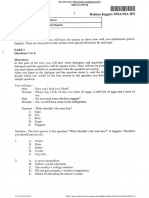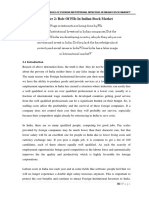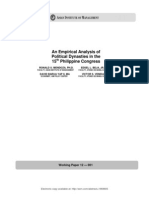Paper Ii General Studies I: Indian Heritage and Culture, History and Geography of The World and Society History
Paper Ii General Studies I: Indian Heritage and Culture, History and Geography of The World and Society History
Uploaded by
Rahul SharmaCopyright:
Available Formats
Paper Ii General Studies I: Indian Heritage and Culture, History and Geography of The World and Society History
Paper Ii General Studies I: Indian Heritage and Culture, History and Geography of The World and Society History
Uploaded by
Rahul SharmaOriginal Title
Copyright
Available Formats
Share this document
Did you find this document useful?
Is this content inappropriate?
Copyright:
Available Formats
Paper Ii General Studies I: Indian Heritage and Culture, History and Geography of The World and Society History
Paper Ii General Studies I: Indian Heritage and Culture, History and Geography of The World and Society History
Uploaded by
Rahul SharmaCopyright:
Available Formats
PAPER‐II
General Studies‐I: Indian Heritage and Culture, History and Geography of the World
and Society
HISTORY [5] 1. Indian culture will cover the salient aspects of Art
Forms, literature and Architecture [A,L,A] from
ancient to modern times.
2. Modern Indian history from about the middle of the
eighteenth century until the present-significant
events, personalities, issues.[SE,P,I]
3. The Freedom Struggle — its various stages and
important contributors/contributions from different
parts of the country
4. Post-independence consolidation and reorganization
within the country.
5. History of the world will include events from 18th
century such as industrial revolution, world wars,
redrawal of national boundaries, colonization,
decolonization, political philosophies like
communism, capitalism, socialism etc.[C,C,S]— their
forms and effect on the society.
SOCIETY [4] 6. Salient features of Indian Society, Diversity of India.
7. Role of women and women’s organization,
population and associated issues, poverty and
developmental issues, urbanization, their problems
and their remedies.
8. Effects of globalization on Indian society
9. Social empowerment, communalism, regionalism &
secularism. [C,R,S]
GEOGRAPHY [3] 10. Salient features of world’s physical geography.
11. Distribution of key natural resources across the
world (including South Asia and the Indian sub-
continent); factors responsible for the location of
primary, secondary, and tertiary sector industries in
various parts of the world (including India).
12. Important Geophysical phenomena such as
earthquakes, Tsunami, Volcanic activity, cyclone etc.,
geographical features and their location-changes in
critical geographical features (including water-bodies
and ice-caps) and in flora and fauna and the effects
of such changes.
PAPER‐III
General Studies‐ II: Governance, Constitution, Polity, Social Justice and International relations.
CONSTITUTION [4] 1. Indian Constitution—historical underpinnings, evolution,
features, amendments, significant provisions and basic
structure. [H,E,F,A,SP,B]
2. Functions and responsibilities [F,R] of the Union and the States,
issues and challenges [I,C] pertaining to the federal structure,
devolution of powers and finances up to local levels and
challenges therein.
3. Separation of powers between various organs dispute redressal
mechanisms and institutions.[DRMI]
4. Comparison of the Indian constitutional scheme with that of
other countries.
POLITY[5] 5. Parliament and State legislatures—structure, functioning,
conduct of business, powers & privileges [S,F,C,PP] and issues
arising out of these.
6. Structure, organization and functioning [S,O,F] of the Executive
and the Judiciary—Ministries and Departments of the
Government; pressure groups and formal/informal associations
and their role in the Polity.
7. Salient features of the Representation of People’s Act.
8. Appointment to various Constitutional posts, powers, functions
and responsibilities of various Constitutional Bodies.
9. Statutory, regulatory and various quasi-judicial bodies.
GOVERNANCE (4) 10. Government policies and interventions for development in
various sectors and issues arising out of their design and
implementation.
11. Development processes and the development industry
[DP,DI]—the role of NGOs, SHGs, various groups and
associations, donors, charities, institutional [D,C,I] and other
stakeholders.
12. Important aspects of governance, transparency and
accountability [GTA], e-governance-applications, models,
successes, limitations, and potential[AMSLP]; citizens charters,
transparency & accountability and institutional [C,T,A,I]and
other measures.
13. Role of civil services in a democracy.
SOCIAL JUSTICE [3] 14. Welfare schemes for vulnerable sections of the population by
the Centre and States and the performance of these schemes;
mechanisms, laws, institutions and Bodies [M,L,I,B] constituted
for the protection and betterment [P,B] of these vulnerable
sections.
15. Issues relating to development and management of Social
Sector/Services relating to Health, Education, Human
Resources.[H,E,H]
16. Issues relating to poverty and hunger.
IR[4] 17. India and its neighborhood- relations.
18. Bilateral, regional and global [B,R,G] groupings and agreements
involving India and/or affecting india’s interests.
19. Effect of policies and politics [PP] of developed and developing
countries on India’s interests, Indian diaspora. [II,ID]
20. Important International institutions[I3], agencies and fora-
their structure, mandate.[AFSM]
Paper-IV
General studies-III-: Technology, Economic Development, Bio diversity, Environment, Security and Disaster Management
ECONOMIC DEVELOPMENT [7] 1. Indian Economy and issues relating to planning,
mobilization, of resources [PMR], growth,
development and employment.[GDE]
2. Inclusive growth and issues arising from it.
3. Government Budgeting
4. Land reforms in India.
5. Effects of liberalization on the economy,
changes in industrial policy and their effects on
industrial growth.
6. Infrastructure: Energy, Ports, Roads, Airports,
Railways etc. [E,P,R,A,R]
7. Investment models.
AGRICULTURE [3] 8. Major crops-cropping patterns in various parts
of the country, - different types of irrigation and
irrigation systems storage, transport and
marketing of agricultural produce and issues and
related constraints; e-technology in the aid of
farmers.
9. Issues related to direct and indirect farm
subsidies and minimum support prices; Public
Distribution System- objectives, functioning,
limitations, revamping[O,F,L,R]; issues of buffer
stocks and food security; Technology missions;
economics of animal-rearing.
10. Food processing and related industries in India-
scope’ and significance, location, upstream and
downstream requirements, supply chain
management.
SCIENCE AND TECHNOLOGY [3] 11. Science and Technology- developments and
their applications and effects in everyday life.
12. Achievements of Indians in science &
technology; indigenization of technology and
developing new technology
13. Awareness in the fields of IT, Space, Computers,
robotics, nano-technology, bio-technology
[ISCRNB] and issues relating to intellectual
property rights
ENVIRONMENT AND BIODIVERSITY [1] 14. Conservation, environmental pollution and
degradation, environmental impact assessment.
DISASTER MANAGEMENT [1] 15. Disaster and disaster management.
INTERNAL SECURITY [5] 16. Linkages between development and spread of
extremism.
17. Role of external state and non-state actors in
creating challenges to internal security.
18. Challenges to internal security through
communication networks, role of media and
social networking sites in internal security
challenges, basics of cyber security; money-
laundering and its prevention
19. Security challenges and their management in
border areas - linkages of organized crime with
terrorism.
20. Various Security forces and agencies and their
mandate.
You might also like
- Solutions-Debraj-Ray-1 Dev EcoDocument62 pagesSolutions-Debraj-Ray-1 Dev EcoDiksha82% (11)
- AMUL Marketing PerspectiveDocument37 pagesAMUL Marketing PerspectivePrasoon Kumar50% (2)
- Ankita Summer Training Report On Training & DevelopmentDocument52 pagesAnkita Summer Training Report On Training & DevelopmentJaiHanumankiNo ratings yet
- Social Issues and The Environment: From Unsustainable To Sustainable Development. Urban ProblemsDocument19 pagesSocial Issues and The Environment: From Unsustainable To Sustainable Development. Urban ProblemsDina Garan100% (1)
- UpscsyllabusDocument5 pagesUpscsyllabusKunal GandhiNo ratings yet
- Syllabus-cum-Class-Plannernew-2Document5 pagesSyllabus-cum-Class-Plannernew-2js2402364No ratings yet
- Paper 2, General Studies I Indian Heritage and Culture, History and Geography of The World and SocietyDocument4 pagesPaper 2, General Studies I Indian Heritage and Culture, History and Geography of The World and SocietyC.V. RajendraNo ratings yet
- UPSC SylubusDocument10 pagesUPSC SylubusDany PaulbabyNo ratings yet
- CSE SyllabusDocument2 pagesCSE Syllabusjainrahul2910No ratings yet
- UPSC Mains SyllabusDocument11 pagesUPSC Mains SyllabusPranav TripathiNo ratings yet
- Mains SyllabusDocument4 pagesMains SyllabusAnupam YadavNo ratings yet
- UpscDocument11 pagesUpscSanskriti NaithaniNo ratings yet
- Iasec Upsc SyllabusDocument1 pageIasec Upsc Syllabusjeseji9510No ratings yet
- Syllabus - UPSC GS (Mains) - Paper1-4Document4 pagesSyllabus - UPSC GS (Mains) - Paper1-4Dikshita BhoirNo ratings yet
- Paper-1: History of Indian Heritage and CultureDocument19 pagesPaper-1: History of Indian Heritage and CultureNIlesh BhagatNo ratings yet
- Part-A Preliminary Examination: WorldDocument12 pagesPart-A Preliminary Examination: Worldkartikeyakodkani2992No ratings yet
- UPSC CSE SyllabusDocument13 pagesUPSC CSE Syllabusyaswanth naga sai muneendra kanuriNo ratings yet
- Upsc Mains SyllabusDocument5 pagesUpsc Mains SyllabusAbhi RajNo ratings yet
- Upsc Syllabus (New) Prelims Syllabus:: Paper 1 (General Studies) Paper 2 (Civil Services Aptitude Test)Document9 pagesUpsc Syllabus (New) Prelims Syllabus:: Paper 1 (General Studies) Paper 2 (Civil Services Aptitude Test)Anonymous Cduq54QlwvNo ratings yet
- UPSC SyllabusDocument4 pagesUPSC SyllabusKaushal SinghNo ratings yet
- Studies-PAPER IIUPSC Exam General Studies - PAPER IIIUPSC Exam General Studies - Paper IVDocument5 pagesStudies-PAPER IIUPSC Exam General Studies - PAPER IIIUPSC Exam General Studies - Paper IVSomoyeta DuttaNo ratings yet
- Numbered UPSC CSM 2013 Syllabus For GS PDFDocument7 pagesNumbered UPSC CSM 2013 Syllabus For GS PDFSushant PatilNo ratings yet
- Mains Syllabus, Booklist & SourcesDocument6 pagesMains Syllabus, Booklist & SourcesPratyush SahuNo ratings yet
- CSP 2013 SylbsDocument6 pagesCSP 2013 Sylbshimhim1200No ratings yet
- GS Syllabus Topic WiseDocument7 pagesGS Syllabus Topic WiseborudeabhiNo ratings yet
- Detailed SyllabusDocument3 pagesDetailed Syllabusdummyem1234No ratings yet
- Cse SyllabusDocument9 pagesCse SyllabusRaju RamNo ratings yet
- Upsc PDF 2Document5 pagesUpsc PDF 2Ajay SinghNo ratings yet
- UPSC PRELIMS General Studies Paper - IDocument6 pagesUPSC PRELIMS General Studies Paper - Ihrobin30433No ratings yet
- SyllabiDocument7 pagesSyllabiHARSHIT PRAJAPATINo ratings yet
- UPPSC Mains Syllabus GS 1^J 2 ^0 3Document3 pagesUPPSC Mains Syllabus GS 1^J 2 ^0 34844xm6zchNo ratings yet
- UPSC Civil Services Preliminary Exam 2014 SyllabusDocument66 pagesUPSC Civil Services Preliminary Exam 2014 Syllabusvishnuvr143No ratings yet
- Mains SyllabusDocument4 pagesMains SyllabusTaniya RoyNo ratings yet
- insightsonindia.com-SyllabusDocument6 pagesinsightsonindia.com-Syllabusrishik.rajsmhsNo ratings yet
- SyllabusDocument5 pagesSyllabusanushkatyagi6867No ratings yet
- Preliminary Examination Paper I - (200 Marks) Duration: Two HoursDocument5 pagesPreliminary Examination Paper I - (200 Marks) Duration: Two HoursrajmastiNo ratings yet
- CSP Syllabus PDFDocument10 pagesCSP Syllabus PDFmaverickvivekNo ratings yet
- csp2013 SyllabusDocument7 pagescsp2013 SyllabusbagheldhirendraNo ratings yet
- Classroom 2 General Studies New Syllabus 661836Document4 pagesClassroom 2 General Studies New Syllabus 661836CA Shrenuj Jalan100% (6)
- Upsc SyllabusDocument6 pagesUpsc Syllabusapoorvaraghuvanshi7No ratings yet
- Structure and Plan of Civil Services Examination: Paper I: General Studies Paper II: Aptitude TestDocument13 pagesStructure and Plan of Civil Services Examination: Paper I: General Studies Paper II: Aptitude TestVikas LatherNo ratings yet
- CSP 2013Document3 pagesCSP 2013Amanda CallahanNo ratings yet
- Schedule (WWW - Freeupscmaterials.wordpress - Com)Document4 pagesSchedule (WWW - Freeupscmaterials.wordpress - Com)alluruswapnaNo ratings yet
- Paper GSDocument3 pagesPaper GSshyamkattiNo ratings yet
- MTS BrochureDocument17 pagesMTS Brochuremanish rajNo ratings yet
- Flow of Things For Next Nine (9) MonthsDocument4 pagesFlow of Things For Next Nine (9) MonthsAshok VenkatNo ratings yet
- Annexure I: PrelimsDocument13 pagesAnnexure I: Prelimstarunc94No ratings yet
- Part A-Preliminary Examination: Upsc SyllabusDocument7 pagesPart A-Preliminary Examination: Upsc SyllabusVeerendra VeeruNo ratings yet
- Handout Cse SyallabusDocument12 pagesHandout Cse SyallabusTejeswara RaoNo ratings yet
- Syllabus Upsc Mains With Geography 2Document7 pagesSyllabus Upsc Mains With Geography 2Krishna Kumar YadavNo ratings yet
- Syllabi For The ExaminationDocument7 pagesSyllabi For The Examinationrahul198918No ratings yet
- La Excellence: Mains Mentorship Program (2018)Document7 pagesLa Excellence: Mains Mentorship Program (2018)Subramanyam BommalataNo ratings yet
- Part A - Preliminary Examination: Paper I - (200 Marks) Duration: Two HoursDocument19 pagesPart A - Preliminary Examination: Paper I - (200 Marks) Duration: Two Hourskrazy CUMarNo ratings yet
- Mains Syllabus and SjkkjnkourceDocument4 pagesMains Syllabus and SjkkjnkourceSipu GiriNo ratings yet
- Mains SyllabusDocument4 pagesMains SyllabusChris HemsworthNo ratings yet
- General Studies - I Indian Heritage & CultureDocument4 pagesGeneral Studies - I Indian Heritage & CultureHexaNotesNo ratings yet
- Syllabi For IASDocument14 pagesSyllabi For IASaj310790100% (1)
- syllabusDocument9 pagessyllabusgautamitheidiotic1No ratings yet
- Syllabus ForDocument9 pagesSyllabus ForDoctor’z AdviceNo ratings yet
- Upsc Ias Syllabus Eng - PDF.PDF 88Document6 pagesUpsc Ias Syllabus Eng - PDF.PDF 88Sumit KumarNo ratings yet
- Real+ Calculus Module G-20 (Maths) : Day Date Unit Topic Sub-Topics (Around 1 HR Total)Document3 pagesReal+ Calculus Module G-20 (Maths) : Day Date Unit Topic Sub-Topics (Around 1 HR Total)Rahul SharmaNo ratings yet
- HALF YEARLY EXAM Accounts-11Document1 pageHALF YEARLY EXAM Accounts-11Rahul SharmaNo ratings yet
- Daily Prelims Notes September 2020 PDFDocument198 pagesDaily Prelims Notes September 2020 PDFRahul SharmaNo ratings yet
- Env 1Document18 pagesEnv 1Rahul SharmaNo ratings yet
- Built Environment DissertationDocument7 pagesBuilt Environment DissertationBuyALiteratureReviewPaperUK100% (2)
- Un Bahasa Inggris Dear MR Jenkins 16 17 Resident 20 22 PDFDocument18 pagesUn Bahasa Inggris Dear MR Jenkins 16 17 Resident 20 22 PDFMA Al Islam SusukanNo ratings yet
- Granville Island 2040: Bridging Past & FutureDocument68 pagesGranville Island 2040: Bridging Past & FutureThe Vancouver SunNo ratings yet
- 06 Handout 1Document6 pages06 Handout 1Justine OrdonioNo ratings yet
- Issues Pak Economy Lec 5 Agriculture SectorDocument38 pagesIssues Pak Economy Lec 5 Agriculture SectorAkash Chhabria100% (1)
- Environmental Management in IndiaDocument4 pagesEnvironmental Management in IndiaNilesh MandlikNo ratings yet
- Chile and The Chilean Wine IndustryDocument39 pagesChile and The Chilean Wine IndustryRiad-us SalehinNo ratings yet
- Chapter 2: Role of Fiis in Indian Stock MarketDocument25 pagesChapter 2: Role of Fiis in Indian Stock MarketWise MoonNo ratings yet
- Pavement Design Guba WenberaDocument9 pagesPavement Design Guba Wenberasamsonabebayehu10No ratings yet
- Answer Key XII Economics Pre Board 2022-23Document6 pagesAnswer Key XII Economics Pre Board 2022-23YASHU SINGHNo ratings yet
- Timeline Analysis: Exploring The Performance of Government Subsidised Housing in South AfricaDocument29 pagesTimeline Analysis: Exploring The Performance of Government Subsidised Housing in South AfricaPrateik KatariaNo ratings yet
- BSBLDR602 - Simulation Pack.v1.0Document21 pagesBSBLDR602 - Simulation Pack.v1.0Dibyendu KarmakarNo ratings yet
- Dr. BoenDocument81 pagesDr. BoenOktavian Rizki IlahiNo ratings yet
- Problems and Prospects of The Jute Product in BangladeshDocument19 pagesProblems and Prospects of The Jute Product in BangladeshSagor199492% (13)
- South Korea PresentationDocument25 pagesSouth Korea PresentationIakovos TheodoulouNo ratings yet
- David Graeber - Introduction To NeoliberalismDocument16 pagesDavid Graeber - Introduction To NeoliberalismJimmy NewlinNo ratings yet
- ESF Population Text C As Worlds Population Booms J Will Its Resources Be Enough For UsDocument4 pagesESF Population Text C As Worlds Population Booms J Will Its Resources Be Enough For Usyousef olabiNo ratings yet
- Quiz - Chapter 26 QuizDocument8 pagesQuiz - Chapter 26 QuizrojascollegeemailNo ratings yet
- Project On Industrial Analysis: Energy Sector: BY: Abhishek Kumar Sinha Kumari Priya Shreel Dwivedi Anwesha ChatterjeeDocument12 pagesProject On Industrial Analysis: Energy Sector: BY: Abhishek Kumar Sinha Kumari Priya Shreel Dwivedi Anwesha ChatterjeesibbipriyaNo ratings yet
- MFO ProjectDocument31 pagesMFO ProjectPrathamesh AwadeNo ratings yet
- An Empirical Analysis of Political Dynasties in The 15th Philippine Congress - Asian Institute of ManagementDocument41 pagesAn Empirical Analysis of Political Dynasties in The 15th Philippine Congress - Asian Institute of ManagementTano Dolores100% (4)
- ECO 8102 Lecture 1Document84 pagesECO 8102 Lecture 1Bonane AgnesNo ratings yet
- The Role of Digital Financial Inclusion On Promoting Sustainable Economic Growth Through Banking Stability: Evidence From BangladeshDocument19 pagesThe Role of Digital Financial Inclusion On Promoting Sustainable Economic Growth Through Banking Stability: Evidence From BangladesholjiragedaNo ratings yet
- Research On Money and FinanceDocument27 pagesResearch On Money and Financefaiqul hazmiNo ratings yet
- V Share Capital Goods Vol-34 - December 2007Document38 pagesV Share Capital Goods Vol-34 - December 2007tarun.mitra19854923No ratings yet
- Case Study - Primus 97 Insurance RestructuringDocument50 pagesCase Study - Primus 97 Insurance Restructuringgauravgupta3093No ratings yet





























































































